According to the survey, 76.1 percent of micro, small and medium-sized companies in Portugal had access to the Internet, compared to 63.5 percent in 2007.
Graph 8 – Penetration of the Internet access service by type of access

Unit: %
Source: ICP-ANACOM, Survey on the use of electronic communications services by small and medium-sized enterprises, December 2010
Base: All companies with less than 250 staff (excludes non-responses)
Note: Estimates: (#) Unreliable estimate; (*) Acceptable estimate; (no symbol) Reliable estimate (see Footnote 2).
In terms of the length of time that the company has had the service, this is naturally longer for the fixed Internet service, compared to the mobile Internet service. Over 56 percent of companies have had their fixed service for over 5 years, whereas 58.2 percent of Mobile Internet customers contracted this service less than 3 years ago.
Graph 9 – Age of Internet access service by type of access
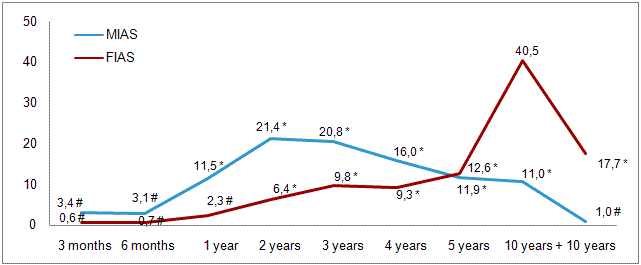
Unit: %
Source: ICP-ANACOM, Survey on the use of electronic communications services by small and medium-sized enterprises, December 2010
Base: All companies with less than 250 staff with fixed or mobile Internet access service (excludes non-responses)
Note: Estimates: (#) Unreliable estimate; (*) Acceptable estimate; (no symbol) Reliable estimate (see Footnote 2).
Of the companies without Internet access, 3 in 4 mentioned that this service was “irrelevant to the company’s business” and around 84 percent reported that they had no intention of taking up the service in 2011.
TMN and Vodafone are the most widely used Mobile Internet providers, with 35.2 and 34.3 percent, respectively.
Graph 10 - Percentage of users of the fixed telephone service by provider
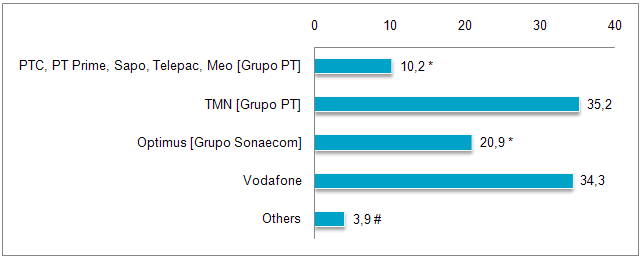
Source: ICP-ANACOM, Survey on the use of electronic communications services by small and medium-sized enterprises, December 2010
Base: All companies with less than 250 staff with mobile Internet access service (excludes non-responses)
Note 1: Estimates: (#) Unreliable estimate; (*) Acceptable estimate; (no symbol) Reliable estimate (see Footnote 2).
Note 2: “Others” includes Grupo ZON, Clix [Grupo Sonaecom] and other providers.
Note 3: Multiple choice question
“Lowest prices” (29.3 per cent) and the “offer of all services as a bundle” (19.8 percent) are the two main reasons given by business customers of the mobile Internet access service for having opted for the current provider of this service.
The equipment most widely used by surveyed companies with Mobile Internet is data transmission cards (52.1 percent), integrated cards (38.7 percent) and mobile telephones or PDAs with broadband access (21.9 percent).
Although the majority of companies which are customers of the mobile Internet access service have a specific offer for companies and professions, this is particularly the case with small and medium-sized companies (71.4 percent) compared to micro-companies (58.3 percent).
The companies which have made complaints to their mobile Internet access service provider indicate “system failures or interrupted connection” as the main reason for complaining (41.4 percent).
Companies which only have the Internet through fixed access indicate that they do not have mobile access because it is “irrelevant to the company’s business” (75.6 percent) or because they “use the Fixed Internet access service” (21.8 percent).
Graph 11 – Barriers to use of mobile Internet Access service
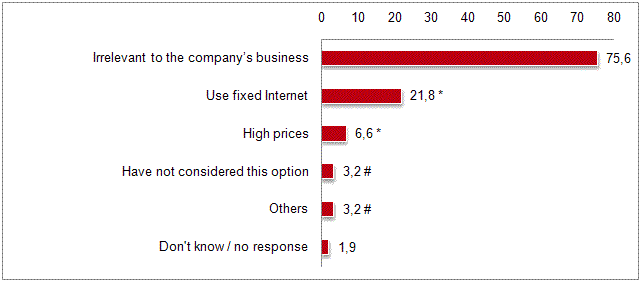
Unit: %
Source: ICP-ANACOM, Survey on the use of electronic communications services by small and medium-sized enterprises, December 2010
Base: All companies with less than 250 staff with fixed Internet access but without mobile Internet access (includes non-responses)
Note 1: Estimates: (#) Unreliable estimate; (*) Acceptable estimate; (no symbol) Reliable estimate (see Footnote 2).
Note 2: Multiple choice question
Almost 1/5 of the surveyed companies with only fixed Internet access report having discontinued the mobile Internet access service, most of them more than one year ago. Meanwhile, 7.8 percent expressed an interest in taking up the service during 2011.
According to the survey, the companies with the fixed Internet access service mostly used DSL (55.5 percent). This type of access is more widely used by small and medium-sized companies (62.5 percent) compared to micro-companies (53.9 percent). There was wider use among micro-companies of narrowband, ISDN or cable.
Graph 12 – Type of connection to the fixed Internet access service
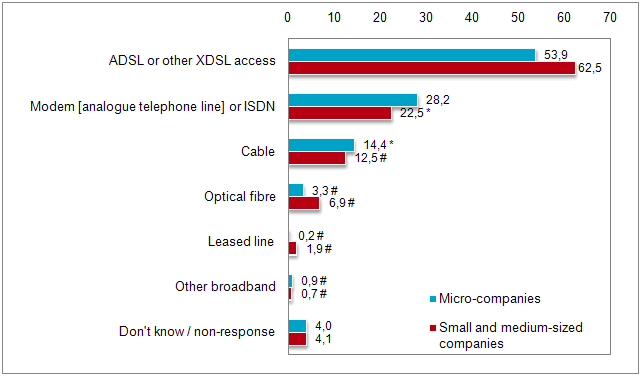
Unit: %
Source: ICP-ANACOM, Survey on the use of electronic communications services by small and medium-sized enterprises, December 2010
Base: All companies with less than 250 staff with fixed Internet access service (includes non-responses)
Note: Estimates: (#) Unreliable estimate; (*) Acceptable estimate; (no symbol) Reliable estimate (see Footnote 2).
Note 2: Multiple choice question
According to the survey, 58.5 percent of surveyed micro-companies had fixed Internet access through a specific offer for companies and professionals. This figure is higher among small and medium-sized companies (72.9 percent).
Grupo PT is the most widely used provider for fixed Internet access by micro, small and medium-sized companies, followed by Sonaecom with 19 percent.
Graph 13 - Percentage of users of the fixed Internet access service by provider
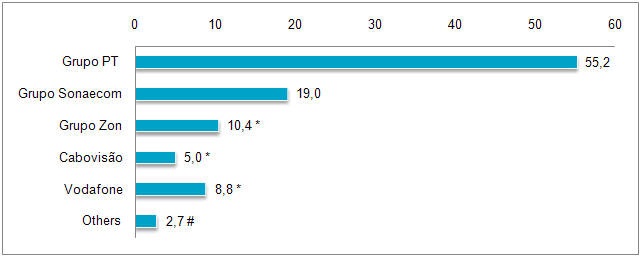
Unit: %
Source: ICP-ANACOM, Survey on the use of electronic communications services by small and medium-sized enterprises, December 2010
Base: All companies with less than 250 staff with fixed Internet access service (excludes non-responses)
Note 1: Estimates: (#) Unreliable estimate; (*) Acceptable estimate; (no symbol) Reliable estimate (see Footnote 2).
Note 2: Multiple choice question
In line with other electronic communication services “lowest price” is the main reason cited for choosing fixed Internet service provider, as indicated by 34.6 percent of surveyed companies which are customers of this service. The fact that the provider is able to “make an offer of all the services in a bundle” is another widely referenced reason for choice of provider, as indicated by 1/5 of customers.
30.9 percent of companies with fixed Internet access reported having submitted a complaint, with 22.2 percent making a complaint in the last year. Small and medium-sized companies tend to submit significantly more complaints than micro-companies (36.1 and 29.7 percent, respectively).
In their majority, the most recent complaint made to the Internet access service provider resulted from “system failures or interrupted connection”, followed by “slow access”.




